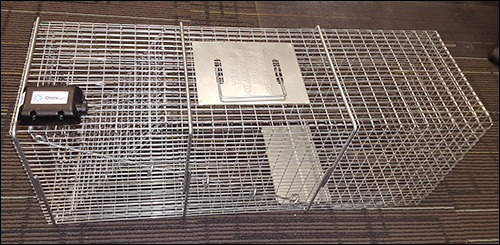Pest-control technicians who work for municipalities, government agencies or private firms spend a great deal of time behind the wheel of a vehicle. In compliance with state and federal animal welfare regulations, the technicians must regularly visit any animal traps they have set—in some cases, as frequently as every 12 hours—in order to check whether the target animal (or perhaps an unintended target) has been caught.
Of course, a good portion of those miles (and corresponding gallons of spent fuel) are wasted, since traps often remain empty for many days. But as it has with so many unlikely niche sectors, as wide-ranging as trash hauling and heating fuel tank management, Internet of Things technology is offering a path to more efficient workflows.

“Traps with monitoring systems started coming on the market about three to four years ago,” explains Greg Smith, who owns the Tomahawk Live Trap Co. Tomahawk is a Wisconsin-based vendor of live traps and accessories, which it sells to animal-control agencies, wildlife services and the U.S. military. Live traps, also known as cage traps, are designed to capture creatures without harming them, so they can be safely released into the wild or returned to their owners. Smith has recently collaborated with OmniM2M, a Seattle-based firm that sells remote monitoring solutions for animal-control services, as well as remote temperature- and tank-monitoring systems for a variety of other applications, to offer Tomahawk traps with integrated wireless monitoring.
The resulting product sports a ZigBee sensor unit that monitors the cage’s trap door and communicates with a gateway from up to 100 yards indoors. The gateway, which can be paired with up to 18 sensors (and, therefore, 18 traps), contains a cellular modem that transmits a message to a cloud-based server to indicate that a trap has been shut, along with the trap’s identifier. From there, the server can send a text or e-mail message to the technician assigned to manage that trap.
“When a trap is triggered, a magnet separates [from the door], and that causes the sensor to send a signal to the gateway,” Smith explains. This sensor unit is small enough to be mounted on most of the traps Tomahawk sells. “There is no limit, really. We can affix the sensor to anything from a 6-foot-long dog trap to 5-by-5 gopher trap—it will work on about 95 percent of our traps.” That remaining five percent includes only the smallest rodent traps he sells, which does not bode well for, in fact, making a better mouse trap. But as sensor manufacturers continue to make ever-smaller devices in the years to come, that is bound to change.
Tomahawk is selling the gateway for $250, while each sensor unit costs $200. In addition to the hardware costs, customers will need to purchase a cellular subscription for each gateway, for which Tomahawk is charging a monthly fee of $30. Other companies that offer remote monitoring for live traps require customers to pay for year-long cellular subscriptions, Smith says, which does not make financial sense for all of his customers. “Especially ones that do not do much business during winter months,” he notes.
Tomahawk previously offered a remote monitoring service through a different technology partner whose sensors did not communicate wirelessly to their gateway, but rather required a wired connection. This meant technicians had a harder time setting up the traps, he r. Plus, the previous partner acted as the main customer-service contact for Tomahawk’s customers, which made Smith feel out of the loop and unable to directly address any issues those customers might have had with remote monitoring system.
Now, Smith and his associates can help customers set up and maintain their remote monitoring system directly.
“Within our cloud-based software, Greg can manage his own accounts. He can go in and set up a customer with the cellular service,” says Gary Schmidt, OmniM2M’s managing director. “This way, Tomahawk can go in and sell the service themselves and manage the workflow, and then OmniM2M provides support to Tomahawk if they need it.”
Smith chimes in: “And we like that a lot.”
In addition, a pest-control agency can use the OmniM2M software to send an electronic registration to local regulators that require reporting on each live trap deployed. Once the trap is collected and the live animal is removed from the premises and released, the technician can use the software to issue a final report to the regulator.
Smith says his customers’ customers like the notion that a live trap with a monitoring system can ensure that animals caught in the trap will be attended to as soon as possible. “You can’t imagine how upset [their] customers can get about trapping and [the potential] cruelty to animals,” he adds.
New Frequency, a Georgia-based firm, sells live animal traps with remote monitoring capabilities, under the Trap-Alert brand, using wired sensors. New Jersey-based Trap Smart also sells a wired sensor solution.

